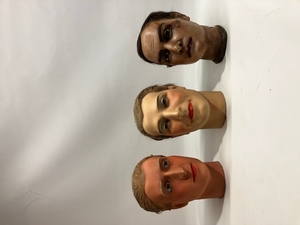News
Object In Focus: A History of Mannequins
Posted On: 19 Dec 2023 by Jodie Merritt to Object In FocusMannequins are a key feature of any shop or fashion designer's studio - but where do they come from, and what is their history? We took a closer look.

Object In Focus: A History of Mannequins
From the earliest recorded history, mannequins have been used to display clothing and fashion,and have stood as a representation of beauty and style for centuries. Today, mannequins are still a popular way of displaying garments in stores and for window displays - not to mention becoming the the focus of countless spooky stories, horror movies, and unsettling scenes: the humble mannequin has developed something of a reputation for malevolence, and has become a prominent figure in pop culture from Daphne Du Maurier to Doctor Who.
In truth, mannequins have a far more domestic purpose: they are muses for fashion designers and artists, and integral elements of the window display of major retailers from New York to London. To celebrate the collection of mannequins due to be featured in our upcoming sale, we took a closer look at the history of mannequins, and the roles that they have played throughout history.
What Is The Purpose of Mannequins?
One of the primary purposes of modern mannequins is to act as an integral part of the fashion industry. They are used in retail stores to display clothing in a visually appealing way, allowing customers to get a better idea of how the item looks when worn, including how it hangs, and how the material is likely to behave. Mannequins can also be used for window displays, giving the store a unique look and attracting more potential customers, and can be used to set up certain themes and scenes, depending on the season or special events.
In addition to their use in retail, mannequins can also be used in museums and art galleries to display sculptures or paintings, and are also indispensable for artists and fashion designers, as they allow the design and creation of clothing that is tailored specifically for the mannequin's body shape - these designs are usually destined for the catwalks of Paris, New York and London, before becoming staples in high street shops across the country.
A History of Mannequins
Mannequins have been around since the dawn of civilisation in various forms, and we have evidence that the Ancient Egyptians, Greeks, and Romans all used mannequin-like figures in their artwork and fashion displays - these items formed a key part of their culture.
The earliest surviving mannequin was discovered in an Egyptian tomb by Howard Carter, who opened King Tutankhamun's tomb to be greeted with an armless, legless torso, with measurements exactly matching that of the Pharaoh. Egyptologists and experts believe that this figure was used as a reference when creating clothing for the Pharaoh, and may be the earliest example of such use.
The mid-19th century saw the rise of mannequins in retail design, and this is largely attributed to the creation of the department store. Stores such as Macy's, Bloomingdale's, and Marshall Field's used mannequins to display their garments in windows and within the stores. During this period, artists and craftsman used natural materials like wax, plaster, and wood to create the figures and create a lifelike effect.
As the 20th century approached, mannequins became a more popular way of displaying garments in stores. However, these early mannequins were not very realistic; they were usually made from plaster or wood, and had a much simpler design than modern models. The first adjustable mannequin was created in the 1930s, and featured a flexible metal armature, which allowed it to be posed in different positions. The next few decades saw a rise in development of materials, including fibreglass, as well as the rise in more detailed models.
Today, mannequins are still used in retail to display garments and fashion accessories. The latest mannequins are made from a variety of materials such as plastic and latex and have realistic features such as detailed facial features and lifelike hair, as well as adjustable limbs.
Mannequins, Society and Body Image
Another interesting point of discussion is the relationship that exists between body image, society and mannequins, and there is no denying that societal developments and ideas have had a significant impact on the way in which these items were designed and used.
The Industrial Revolution saw huge shifts in dress forms, and this was the first time that the shop-front was transformed from a practical piece of real estate into a space of action and influence. Here, we saw mannequins bequeathed in the latest fashions, and the use of the mannequin evolved from merely being a form with which to tailor and measure dresses, into a means of advertising, and a vessel for displaying and selling clothing. The early 20th century saw dress forms given legs, and given the ability to be moved into one of three positions - with both legs together, or with one foot forward at a time. This movement, combined with the overly large busts of the mannequins, gave rise to a more human feel, and formed early examples of fashion influencing.
This period also saw the changing of the waist on dress forms, cinching it in for a classic hourglass look which lent itself perfectly to the display of corsets, and which aligned perfectly with the end of the Victorian period, and the censorship of the female body which was so symbolic of that era. The female form was celebrated and shown off, and the dress forms and mannequins gave women a real insight into the way they could expect outfits to hang and appear on their own bodies. There were, of course, critics, namely groups of Christian women who objected to the display of corsets in shop window, and those who objected to the female form being dressed and undressed in the "public" space of the shop window - the latter comment resulted in some windows being covered while the mannequin was being changed.
World War I saw yet more changes, with corsets falling out of favour, and shorter, more practical outfits appearing, including those which dared to bare a knee or ankle. Clothing became more practical, and mannequins followed suit, displaying a more realistic, expressive and natural appearance, and this was followed by yet more changes during the Art Deco movement. Once again, the mannequins and dress forms can be seen as a visual representation of the morals and ideas of society - particularly in relation to the appearance and image of women.
An Image Of Time
It is clear that mannequins have evolved greatly over the years as society's attitudes and desires have changed. The mannequin has been a reflection of fashion, an icon of beauty, and a visual representation of societal changes throughout history, with each example offering us an insight into the ideas and values of the time.
Here at Ryedale Auctioneers, we are thrilled to work alongside a range of mannequins, puppets and dress forms, and our most recent collection involves this unique set of three mannequin heads, dated to the 1930's, and most likely attributed to French creators. The realistic facial features, authentic - most likely horses - hair, and decorated faces all offer us a glimpse into a time gone by, and we are delighted to be presenting this snapshot of history at our upcoming auction on 4th January - 5th January.
Keep an eye on our social media and website to check out the catalogue, and come to see for yourself the beauty and history of this unique collection!

